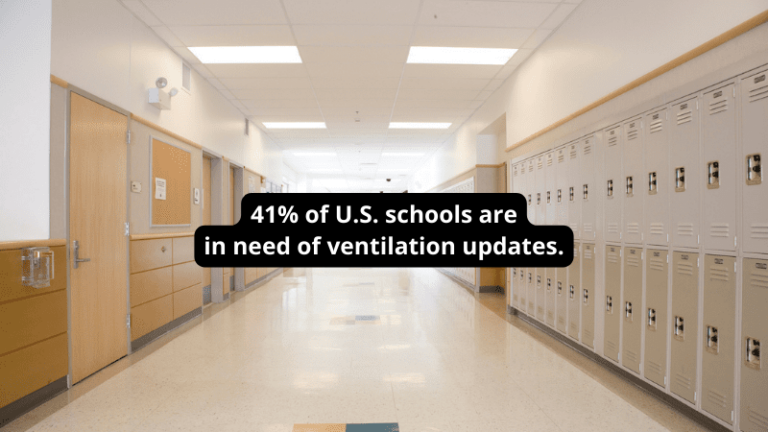The New York Times recently published an article by education reporter Sarah Mervosh that asks who runs the best public U.S. schools.
The answer? The Pentagon.
On last year’s NAEP Report Card, the Department of Defense schools blew other public schools out of the water—all while skirting around pandemic learning loss, behavior decline, and other issues facing public schools.
So what do Defense Department schools do differently? How are these schools able to manage the extremely tense culture wars, learning loss, and shortages plaguing every other public school district right now?
In short: The nature of these schools means they don’t have these problems in the first place.
Here’s what the article points to as key differences that set Department of Defense (DOD) schools apart.
1. Families have access to housing and healthcare
With military housing and healthcare, students are coming to school with their basic needs already met. A starting point miles ahead of other public schools.
2. Their teachers are paid more
Quality teacher retention is easier when teaching is an attractive, sustainable profession. An elementary teacher quoted in the article more than doubled her salary transferring to DOD from public schools in Florida—she now makes $88,000 per year. With a budget of $3 billion per year, their spending far exceeds other districts of their size.
3. Their schools are fully funded
Many teachers can’t imagine what it would look like to work in an adequately funded school. Perks like stocked supply closets. Band-Aids. Mental health counselors. Hand soap in the bathrooms. Technology. IT roles to troubleshoot that technology. What does that even look like?
But funding isn’t just about providing supplies or staffing. It’s about not burdening teachers to bridge the gap when those resources aren’t provided.
From the article: “While much of the money goes toward the complicated logistics of operating schools internationally, the Defense Department estimates that it spends about $25,000 per student, on par with the highest-spending states like New York, and far more than states like Arizona, where spending per student is about $10,000 a year.”
You’ll want to click on that link to see what the spending per student is in your state, by the way.
4. Their schools are more integrated than most public schools
Many U.S. public schools are de facto segregated by class and/or race. As the article states, “… nearly 40 percent of Black and Hispanic public school students attended a high-poverty school—a rate three to five times that of Asian and white students.” As most teachers can tell you, these divisions create huge inequalities from school to school. Not just in terms of physical resources, but in staffing, conditions, and overall opportunity.
But military bases are different. Because of the range of employment necessary to keep a base running, DOD schools are more socioeconomically and racially integrated than many schools in America. The article nods to the desegregation of the military and its schools in 1948, years before the rest of the country. It also acknowledges, however, that the military isn’t perfect in terms of achieving racial equality—or equality based on other factors. From former Georgetown University sociologist Leslie Hinkson: “The military isn’t perfect—there is still racism in the military.” But what does she say set DOD schools apart? “Access to resources in a way that isn’t racialized.”
5. DOD schools have a strong, central structure
One of the key differences that set apart the DOD system is centralized leadership. Unlike most public schools, Department of Defense schools are not subject to the leadership of local school boards, whose motivations, influences, and decision-making can look wildly different from district to district and from state to state.
A central structure also ensures equal distribution of resources. In far too many public schools in America, funding is tied to zip code. That is, your educational opportunity is determined by the neighborhood your family can afford to live in. In Houston, for example, Travis Elementary—a public school with a 94.22 rating, a gifted magnet program, and a garden—is less than 2 miles away from Looscan Elementary, a school whose library was converted to a discipline center this summer as one of the superintendent’s ideas for reform.
Alternatively, in DOD schools, a kindergartner who started this fall at Van Voorhis Elementary on one side of Fort Knox will be getting the same education, support, and opportunities as a kindergartner at Kingsolver Elementary 3 miles away.
6. Common curriculum
Every few years, another state or district overhauls the way students learn. A new standardized test. A new curriculum. Often these overhauls occur with scant input from teachers, minimal teacher support, haphazard enforcement, and sometimes just weak curriculum.
The DOD also overhauled their curriculum recently. But unlike many public school systems and initiatives, they rolled it out in carefully organized stages over several years, including teacher training and global coordination to ensure every school is aligned. That way, if a parent of the kindergartners I mentioned earlier in Fort Knox is reassigned to a post in Belgium, the child will pick right back up on their learning at Brussels American School.
One drawback is the lack of teacher autonomy. The article details 8th grade math teacher Cicely Abron’s inability to use any supplemental curriculum or materials from her 20 years of experience. But it also says she gets detailed feedback and support from administrators and coaches, plus dedicated time in her schedule to plan with her team. (I think they were presented as downsides, but these would be huge perks to plenty of teachers.)
Other advantages of a common curriculum (if it’s high quality and well implemented)? Less prep. More manageable for new teachers. And a greater opportunity for shared, communal excellence instead of the “pockets of excellence” effect that happens when strong teachers are scattered throughout a school.
After reading about the success of DOD schools, the natural question is, “Why can’t we do this for non-military public schools? What will it take?”
A lot of things. Time. Money. But the main one? Listening to teachers.
After all, we’ve been saying these things all along.
For more articles like this, be sure to subscribe to our newsletters to find out when they’re posted.


